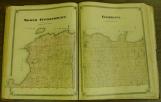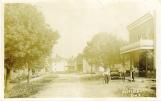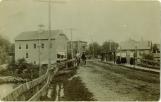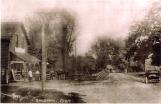1
Steamer Enterprise loading and unloading at Jackson's Point.1900
Lake Simcoe, Jackson's Point, Ontario, Canada
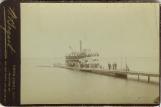
2
"In the settlement of the province, the pioneer at first followed the course of the shores of the lakes, bays, rivers and the smallest streams. And wherever was found an Indian path, it was pursued."-Historical Atlas of York County. Toronto: Miles and Company, 1878
4
Georgina Township, named in honour of George III during the governorshop of Simcoe, was surveyed in 1917 by Duncan McDonald under instructions from Surveyor-General Thos. Ridout. From 1826 to 1970 the township was separated for administrative purposes into two townships: North Gwillimbury to the west and Georgina to the east. The township, comprising 34,996 acres, is characterized by varied soil conditions ranging from good agricultural land to swampy and sandy soil. It was her pine-forested shoreline, however, which produced the most interesting centres of development, and although small pockets developed in Udora, Egypt, Baldwin, Vachell, and Virginia, the three principal settlements in the 19th century were Sutton, Pefferlaw, and the Lake Shore Road.8
On Lake Shore Drive, looking east towards Jackson's Point.1915
Lake Shore Drive, Jackson's Point, Ontario, Canada
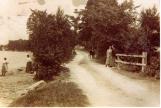
9
North Gwillimbury grew up around four centres: Roche's Point, Keswick, Jersey, Belhaven. Historically, Lake Simcoe and the Holland River formed the principle communication route from the north to the south of Upper Canada, and North Gwillimbury held a beneficial position along this route. "Upper Canoe Landing," in early days, was a site much used by Natives engaged in bartering with the fur traders. A mile and a half further down from the Upper was the "Lower Landing." Here, with the Holland River is about 25 feet wide, was "Pine Fort" also known as "Gwillimbury Fort."Gov. Simcoe, realising the importance of good communications for the new Province, caused a survey of a route from Toronto to Lake Simcoe to be made in 1795. It was called Yonge Street after Sir George Yonge, Secretary of War in the Home Government of 1791. By 1829 a stage coach was able to make daily trips along this route from Toronto to Holland Landing. It provided seats for six passengers and was drawn by four horses. This meant untold benefits for the growing township. In 1821 the total number of inhabitants in North Gwillimbury and Georgina was 272. The next year it had risen to 314 and in 1829, North Gwillimbury alone had 339 inhabitants.
The town of Belhaven, formerly known as "Plug Mount," so named after a gentleman who wore a "Plug" or Stove Pipe Top-Hat when he met the daily coach, was situated at a central point in the township. This was the position of the Town Hall and was the starting place of the daily coach which ran to Newmarket via Keswick, Jersey, Queensville and Sharon.
